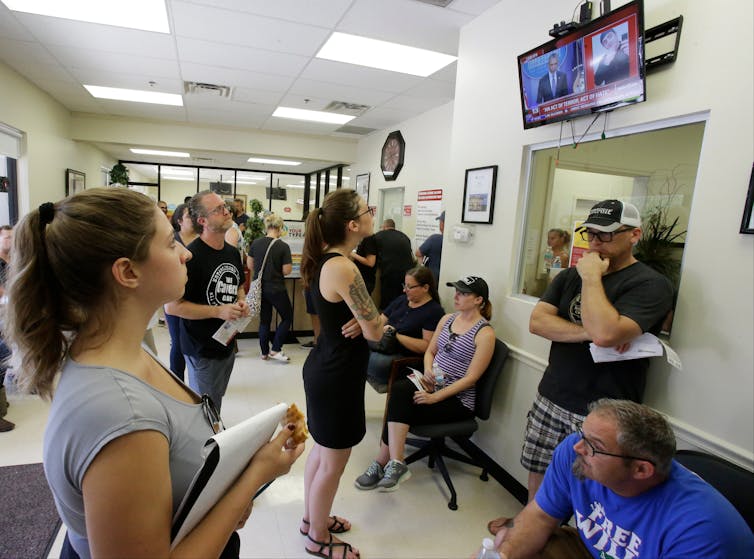Why Biden Should Pick Kamala Harris for VP
She can not only help him win—she can advance the anti-racism agenda.
POLITICS
 Gage Skidmore
Gage Skidmore
Joe Biden and his vice-presidential vetting team have their work cut out for them. They bear the responsibility of choosing a running mate who can garner excitement, advance the progressive agenda, help reverse systemic racism, and appeal to independents and moderate Republicans. The stakes are immeasurably high: It’s hard to fathom what four more years of Donald Trump in the White House would do to our country.
As the pandemic and the mass protests over George Floyd’s murder have revealed, the nation is still reeling from centuries of racial injustice and inequities. In this fragile moment, Biden has an incredible opportunity help heal the country through the selection of his running mate.
Of course, Biden has a delicate needle to thread. He needs someone who appeals to the black community and can seize on the momentum surrounding the anti-racism movement. He needs to galvanize support among the liberal army of voters who supported Bernie Sanders or Elizabeth Warren. At the same time, he can’t alienate the moderate voters and Never Trumpers who helped carry the 2018 blue wave.
Biden has already committed to picking a woman to join him on the ticket. The good news is, he has an abundance of riches to choose from—whether Elizabeth Warren, Val Demings, Kamala Harris, Susan Rice, or Keisha Lance Bottoms. All of them would serve with honor and distinction as the nation’s first female vice president.
But given the condition of the country—following the brutal killings of not only Floyd but Ahmaud Arbery, Breonna Taylor, and Rayshard Brooks—Biden would be wise to choose a qualified black woman. Such a pick would not only speak directly to the concerns of African Americans who have felt they have not been represented in the halls of power, it could help catapult Biden from his Delaware basement to the Oval Office.
There is one woman who could do this better than the rest: Kamala Harris. (Full disclosure, I helped her presidential campaign, so my support of Harris runs deep.)
Selecting the Black California senator would not just be “symbolic,” as Professor Laurence Tribe suggested this week to the Washington Post after signing a letter recommending the former vice president choose Warren. “I think African Americans above all would be the first to say they are more interested in results than cosmetics,” said Tribe.
What Professor Tribe—and much of the media—seem to miss consistently is that Harris isn’t merely symbolic. She has the receipts. Most recently, she has used her perch as a U.S. Senator to elevate the concerns of minorities and address them with purposeful and data-driven policy solutions. For example:
- Harris introduced with Rand Paul The Pretrial Integrity and Safety Act of 2017, a bipartisan bail reform bill that encourages states to reform or replace the practice of money bail.
- Harris introduced the Water Affordability Act of 2018, legislation that would help low-income families across the country pay for rising sewer and water bills.
- Harris and Congresswoman Pramila Jayapal announced the Domestic Workers Bill of Rights Act, the first ever national legislation ensuring the rights and protections of millions of domestic workers—who are largely persons of color.
- Harris and members of the Black Maternal Health Caucus introduced a historic legislative package to address the United States’ urgent maternal health crisis. The Black Maternal Health Momnibus Act of 2020 seeks to improve maternal health outcomes of Black women, as well as other high-risk populations, including female veterans, incarcerated women, and Native Americans.
- Harris and Congresswoman Ayanna Pressley proposed the Saving Our Street Act, a bill designed to benefit local institutions, like bodegas or small cafés, with fewer than ten employees, often which are minority owned.
- Last but not certainly not least, Harris joined top Congressional Democrats in unveiling the Justice in Policing Act of 2020 to address police brutality.
Harris’ tenure in the Senate speaks volumes to her values and priorities. And although progressive legislation like hers has not stood a chance in Trump’s Washington, or with Mitch McConnell as Senate Majority Leader, Harris has proven herself as a leader who can take big ideas and swiftly turn them into legislation ripe for a Democratic majority.
By choosing Harris, Biden would signal that he shares the same concerns of Black Americans and would be committed to advancing equality as president. It would also show that he wants someone by his side who can not only beat Trump, but immediately begin cleaning off the stain of his presidency.
Harris’ lifelong career in public service—from her time as California’s attorney general, and her tenure in the U.S. Senate—render her fully qualified and prepared to serve as vice president. (She’s certainly no less qualified than Biden’s former boss was at the time he became president.) Harris’s race and gender are not what would make her a good number 2; it’s her skills, values, intelligence, and experience. But her race and gender make her even more perfect for the moment.
Still, there are plenty of other reasons to believe a Biden-Harris ticket would be successful.
Biden will have prudently chosen a VP that voters can rely on to hit the ground running. As California’s chief law enforcement officer, Harris ran the second largest justice department in the country. She has significant executive experience running an agency, managing a budget, and making tough decisions. Harris’s readiness appeals to the voters anxious to fix the damage of the Trump administration.
A Biden-Harris ticket also communicates that Biden is comfortable with a fighter. Since joining the Senate in 2017, Harris has leveraged her prosecutorial chops on the Senate Judiciary Committee to take on Brett Kavanaugh, Bill Barr, Michael Horowitz, and a host of Trump’s other unqualified judicial nominees. With her razor-sharp and well-proven debate skills, Harris would eviscerate Mike Pence on the debate stage.
Twenty years Biden’s junior, Harris would bring relative youth and energy to the ticket. For a younger electorate that has only known Barack Obama and Donald Trump, Biden has an uphill battle in inspiring millennials. Choosing someone significantly younger can help reassure voters who are concerned about Biden’s advanced age and want a vice president able to lead in case of an emergency.
Like everyone else on the VP shortlist, Harris doesn’t come without some baggage. Most notably, the progressive coalition has taken issue with her prosecutorial record in California, claiming she was too aggressive in pursuing drug charges and long sentencing.
Recently, however, even some of her most vocal progressive detractors, such as Lara Bazelon and Shaun King, have conceded she would serve Biden well as his vice president. That’s because she’s worked deliberately in the Senate and on the campaign trail to tackle criminal justice reform. In fact, Harris knows the criminal justice system’s flaws intimately and has made that abundantly clear in her media appearances since the national Black Lives Matter protests began. If anything, the last few months have solidified that Harris is a smart and shrewd politician who knows how to seize the moment, connect with voters, and advance an agenda.
Of course, we can’t ignore the fact that Biden choosing a woman of color as his running mate would mark enormous progress for the country. With Harris, we have someone who can not only fill that role, but serve as a damn good vice president.
Harris would also bring another essential feature to the Biden ticket: She would reflect the diversity of America. She attended and graduated from Howard University, a historically black university, and the University of California, Hastings College of Law in San Francisco. She’s the daughter of an Indian mother and a Jamaican father. She talks frequently and lovingly about her own single working-class mother—and the lessons she provided her.
Harris wedded later in life into a biracial marriage with a Jewish entertainment lawyer named Douglas Emhoff. To even the casual observer, it’s clear Harris and Emhoff have a warm, genuine relationship. And though she doesn’t have her own children, she’s a devoted stepmother to Emhoff’s children.
Notably, there’s not a whiff of elitism to Harris, despite her professional accomplishments. She shows ordinary Americans that she is one of us. That’s not nothing: Her warm demeanor can resonate with voters. She has a knack for using social media to connect with them on a more personal level. She loves cooking and even taught Senator Mark Warner how to make a proper tuna melt on Instagram live. In short, she has a unique ability to draw from her no-nonsense prosecutorial background at noon, while welcoming us into her kitchen at night.
Simply put, Harris is uniquely suited to help Biden by leveraging that warmth, relatability, and diversity of experience to win a coalition of the Black, Latinx, and AAPI vote. Not to mention, she can help Biden bring in the college-educated white women Hillary Clinton failed to sway.
As we all know, this is a bizarre election. It’s also the most important of any of our lifetimes. Biden has a slew of great choices in a female running mate. But as the last several weeks of our national crisis have crystalized, America needs him to pick the best possible option.
Kamala Harris will send an unequivocal message to voters that justice and the integrity of our nation are on the ballot this November. Perhaps most importantly, Biden can prove with Kamala by his side that he is ready to govern in a post-Trump era—and committed to making sure this country starts treating black lives like they really do matter







 FOX NEWS POLL
FOX NEWS POLL 
